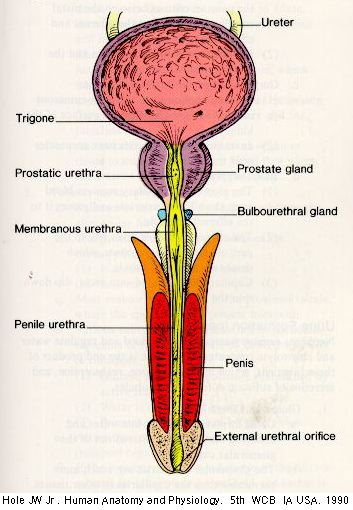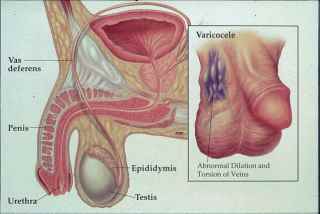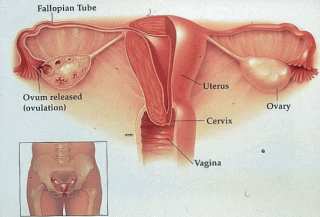
Male Reproduction


The male reproductive system includes the testes where sperm production occurs every 72 days. The sperm are delivered by the epididymis and vas deferens into the urethra where ejaculation occurs through the penis. At the time of ejaculation, the valve into the bladder is closed, thus inhibiting retrograde ejaculation into the bladder. The seminal vesicles and prostate gland contribute nourishing fluid for the sperm to live in while in the ejaculate. It is important that the testes be somewhat cooler than the rest of the body so that effective spermatogenesis can occur.
The Female Reproductive System

This includes the vagina where sperm are deposited, the cervix where mucus is produced which provides a reservoir for the ejaculated sperm, the uterus where the pregnancy develops for nine months, the fallopian tubes which provide a conduit for sperm and eggs, and the ovaries in which ovulation occurs as a monthly phenomenon.
The hypothalamus and pituitary glands are extremely important for the development of eggs in the female and sperm in the testicles. In both sexes, the gonadotropin-releasing hormone is released in pulses from the hypothalamus at the base of the brain sending a message to the pituitary gland to produce the hormones FSH and LH.
In the ovary, the FSH and LH provide a signal for the development of
eggs. As egg development occurs, the hormones estrogen and inhibin , produced
by the ovary , provide negative feedback to the hypothalamus and pituitary.
This feedback causes the production of FSH and LH to decrease. In the failing
ovary, (pre-menopausal) estrogen and inhibin levels are low; the negative feedback
is inhibited; and FSH and LH levels may be high, signifying imminent ovarian
failure.
In the male, the FSH and LH act on the testicles to facilitate sperm production.
Again, there is a negative feedback loop through the pituitary and hypothalamus
via the hormone testosterone.
The hypothalamus is an extremely sensitive part of the human brain, especially in females. Changes in diet, excessive weight gain or loss, excessive stress, exercise, emotional upheaval, and even alterations in the light/dark cycles may alter its function. These alterations effect the GnRH pulses and hence pituitary function with alteration in the secretion of the hormones FSH and LH.
These changes effect ovarian function with alterations in the production of estrogen, which prepares the uterus to accept an embryo and progesterone, the hormone of the luteal phase, which is important in maintaining a pregnancy. Thyroid hormone balance is also extremely important to the overall functioning of this system.
Because of the hormonal changes discussed above, a female undergoes a monthly menstrual cycle. In the first half of the cycle, (proliferative phase), the lining of the uterus is developed so that an embryo can implant. This is the estrogenic phase. The second half of the cycle is characterized by the secretion of progesterone (secretory phase) to maintain the lining of the uterus.
Ovulation is the event that occurs between the proliferative and secretory phases, and is usually mid cycle. At the end of the secretory phase (which usually lasts fourteen days), menstruation (shedding of the lining of the uterus) occurs if there is no pregnancy.
The hormonal events in a normal menstrual cycle are complex. FSH is secreted from the pituitary gland causing the ovaries to produce estrogen. Just before ovulation, the hormone LH is released from the pituitary gland, triggering and ovulatory response in the ovary. (This is a hormone measured in ovulation prediction kits and is in the blood stream for a short time).
After ovulation, progesterone is secreted by the corpus luteum of the ovary and functions to maintain a pregnancy.
If sperm have been placed in the uterus at the time of ovulation, they
swim into the fallopian tubes and encounter an egg that has been released from
the ovary. The sperm enters the egg (fertilization) and such a union of a sperm
and egg forms a zygote. This is the beginning of life.